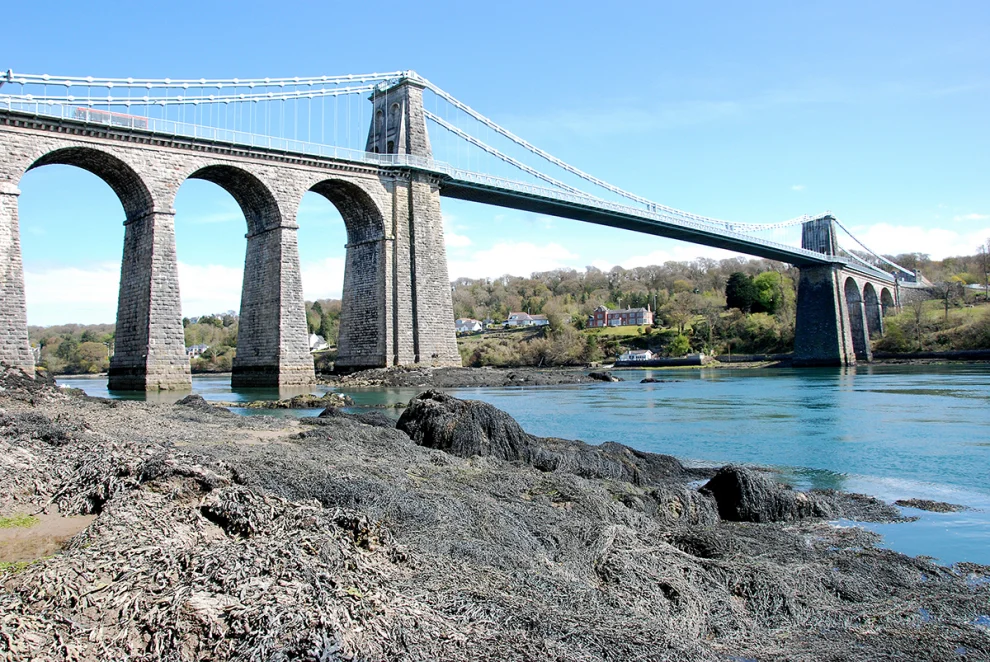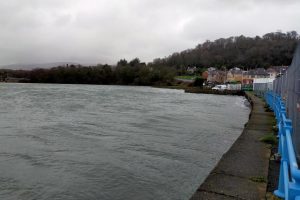SUSPENSION bridges make up some of the greatest architectural attractions in the world – most notably the Golden Gate Bridge, however the first suspension bridge was actually built in Wales – Anglesey to be exact.
For centuries, travel to Anglesey from the mainland was often hazardous. Ferries traversed the Menai Strait at various places, but the currents are tricky and numerous boats capsized or ran aground, often with loss of life.
One of the most tragic occurred in 1785 when a boat carrying 55 people became stranded on a sandbar in the middle of the southern end of the strait. Attempts to refloat the boat left it swamped.
The alarm was raised and rescuers set off from Caernarfon. But, the combination of high winds, nightfall and the fear of also running aground meant that the rescuers could not approach the sandbar. Night fell, the tide rose and those stranded on the sandbar were swept away. Only one survived.
Traffic across the strait and Anglesey increased in the early 19th century after the Act of Union of 1800, when Ireland joined the United Kingdom.
Travellers to the ferry port of Holyhead, where ships left for Ireland, had to make the dangerous crossing after a long and arduous journey from London.
Soon plans were drawn up by Thomas Telford for ambitious improvements to the route from London to Holyhead, including a bridge over the Menai
One of the design requirements for the bridge was that it needed to have 100 feet of clear space under the main span, to allow for the passage of the tall sailing ships that plied the strait.
This was done by designing a suspension bridge, with sixteen massive chains holding up a 579 foot length of road surface between the two towers.
Although small suspension bridges had been built before, none approached the scale that Telford proposed for this one.
Despite much opposition from the ferry owners and tradesmen in the ports, construction of the bridge started in 1819.
The stone used for the arches and piers was limestone quarried from Penmon Quarries at the north end of the strait, then carried down by boat. The ironwork came from Hazeldine’s foundry near Shrewsbury.
To prevent the iron from rusting between production and use on the bridge, the iron was immersed, not in boiling wine as the White Knight suggested above, but in warm linseed oil.
The stonework was finished in 1824; then began the monumental task of raising the chains that would hold up the central span. Tunnels were driven into solid rock on either shore to anchor the chains.

Then the first section of the chain was secured on the Caernarfonshire side. More sections were were added to the chain, resting on wooden scaffolding that led up to the top of the eastern tower.
Another chain was built up to the top of the tower on the Anglesey side. The central section of chain, weighing 23.5 tons, was then loaded onto a raft, carefully manoeuvred into position between the towers and connected to ropes dangling down from the towers.
While a fife and drum band played to encourage the workers, 150 men used block and tackle to draw the chain up to the top of the Anglesey tower to complete the span.
The large crowd that had gathered to watch cheered wildly as the connection was made.
The remaining fifteen chains were raised in a similar manner over the next ten weeks. Rods were then hung from the chains and bolted to iron bars that were used as the base for the wooden road surface.
The bridge was opened on 30th January 1826 to great fanfare. Its completion, along with other improvements to the road by Telford, reduced travel time from London to Holyhead from 36 hours to 27 (today it takes 5.5 hours).
The bridge has been modified and reconstructed many times over the years. The road surface was damaged in severe winds in 1839 and needed repair. The wooden deck was replaced with a steel one in 1893. With the coming of modern vehicles the previous weight limit of 4.5 tons per vehicle became an impediment.
Overweight vehicles would have to carry their loads over in two or more trips. In fact, even bus conductors would regularly have to ask some passengers to walk across.
So, between 1938 and 1940 the old iron chains were replaced with new steel ones, all while traffic continued to cross.
In the autumn of 1999 the bridge was closed for several weeks to completely replace the road surface and strengthen the bridge.
The completion of the Menai Bridge was a boon in easing the journey to the island, particularly for travel to Ireland.
However, the rapid rise of rail travel later in the 19th century meant that there was soon a need for trains to cross the Strait.
When plans were first being made to build a railway to Holyhead it was proposed that the carriages be taken over the Menai Bridge; the carriages would be uncoupled from the locomotive at one end, then drawn across one by one, using horses, to a waiting locomotive at the other end.
This idea was abandoned and plans were drawn up for a new bridge by Robert Stephenson, son of the locomotive pioneer George Stephenson.
He faced the challenge of building a bridge rigid and strong enough to carry a heavy train of many carriages. This was done by making the bridge out of two long iron tubes, rectangular in shape, through which the trains would travel.
When first conceived, the tubular bridge was to have been suspended from cables strung through the openings at the tops of the towers. However, after engineering calculations and tests of the finished tubes it was decided that they were strong enough by themselves to carry the trains.
Like the Menai Bridge, the stonework of the Britannia Bridge was constructed of limestone from Penmon, although sandstone from various places was used internally. The tubes themselves were constructed on the banks of the Strait.
Stephenson faced a much greater challenge in raising the 1,500 ton finished tubes than had Telford with his much lighter chains. He too would float the tube into position.
However, the process didn’t go as smoothly with the first tube as with the Menai Bridge chains and the giant tube came close to being swept out to sea. Fortune prevailed and it did finally end up in place.
Then, very slowly, using hydraulic pumps, the tube was raised into position. Stonework was built up under the ends of the tube as it was lifted; this was to support it if the lifting equipment failed.
This was fortunate because one pump did indeed fail, but the tube only fell nine inches.
With the tubes in place the final touches were added. These are the four magnificent limestone lions that guard the entrances to the bridge.
They were carved by John Thomas, who had also done stone carving for the Houses of Parliament and Buckingham Palace in London. The lions are almost 4 metres high and sit on plinths of equal height. The bridge was opened on 5th March 1850.
The present day bridge has a much different appearance than the original. This is because it has been reconstructed after a disastrous fire in 1970.
A group of teenagers looking for bats in the dark tubes accidentally dropped the burning paper they were using as a torch. This eventually started a ferocious fire through the whole tubular structure that caused so much damage to the tubes that they were in danger of falling into the strait.
As assessments were being made as to how to repair the bridge, the local County Surveyor came up with the clever idea of making two bridges out of one. For many years there had been discussions of building a third bridge across the strait to ease the traffic congestion on the Menai Bridge. It was proposed that the Britannia Bridge be rebuilt as a two level bridge carrying both trains and road traffic.
Rather than being a tubular bridge the new span is now supported by arches. A single railway track carries the trains to and from Holyhead. On top of this is a roadway carrying traffic on the A55 Expressway.

















Add Comment